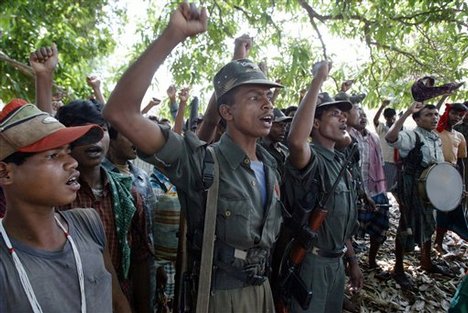 Philip Ferguson The Spark November 2010
Philip Ferguson The Spark November 2010
In the lead-up to the Commonwealth Games the media was full of criticisms of India. All these, however, revolved around whether the Games’ facilities would be finished and good enough, what the quality of the athletes’ village was and whether athletes would be safe from the supposed dangers represented by Islamic fundamentalists.
What was never touched upon in any serious way was the position of the mass of Indians themselves. Indeed, the media continues to promote the number one global myth about India: that it’s the world’s biggest democracy. In point of fact, India is a country marked by lack of democracy, by vicious state repression and huge inequalities of wealth and power.
Nearly 90% of the population have less than one (US) dollar to spend a day – in terms of purchasing power parity that equates to about US$2.50 a day. Half of India’s children are under-nourished. Illiteracy remains widespread – in rural areas, for instance, almost half the women cannot read or write. Peasant plots of half a hectare to five hectares mean they’re not viable for families, while 80 million rural workers (1/3 of the rural workforce) are landless labourers. In the past decade, 200,000 peasants have committed suicide, frequently using pesticide poisons, because they can’t repay exorbitant loans. From the mid-1990s to the mid-2000s average calorie and protein intakes in rural areas declined by 5%.
Under the ‘more market’ policies pursued since the 1980s, social inequality has massively risen. In the 1990s, for example, the top 0.01% of Indian households saw their incomes rise by 150-200 times. Since this was based only on income tax returns, the real rise was probably even higher. The new elite in India are not overly interested in investing in the productive sphere of the economy, let alone in improving the wages, conditions and living standards of the vast majority. They prefer to spend their money on buying private jets, massive new mansions and other luxury goods. They even shop in gated malls, from which ordinary Indians are excluded.
Dalits (formerly known as “Untouchables”) make up about 30% of the population. While untouchability was officially abolished by the 1952 Constitution, it was never abolished in fact. Dalits are still segregated, especially in rural areas, and still confined to jobs such as garbage collection and hauling excrement.

Adivasis (the tribal/indigenous population) number about 100 million and largely live in forest areas in central and eastern India. Their presence dates back before the Aryan conquests. They have collective customs and no caste system. They are subject to repression and discrimination. Especially since the areas they have inhabited for thousands of years are among the most resource-rich in India, there are continual, and increasingly brutal, attempts to drive them off their land in order for big multinational mining companies to grab the land (see,for instance, http://www.survivalinternational.org/films/mine). The plundering of these parts of India by vulture companies creates the “irony that the mineral-rich states are the poorest states of the country” (Business Standard, 20/12/07).
The Adivasi regions are also a centre of opposition to corrupt local and central government. In recent years there has been a substantial growth of support in these areas for the Maoist movement, the Communist Party of India (Maoist) and its People’s Liberation Guerrilla Army. The Maoists have established liberated areas in which the people rule themselves directly. They’ve carried out land reform, taken substantial steps to organise women and promote gender equality and assist people in generally providing for their human needs. The model of society in the liberated areas is a threat to the intensely hierarchical structure of Indian society, where capitalism, feudalism and caste are intertwined. These areas are therefore subject to murderous campaigns by the state, most particularly Operation Green Hunt.

This offensive is designed to kill two birds with one stone: destroy the Maoists and push the Adivasis off their land so it can be opened up to unbridled exploitation by mining and other big western corporations. It was launched towards the end of 2009, following the failure of terror gangs, linked directly to local state governments and corrupt political parties along with their corporate friends such as Tata and Essor Steel, to achieve the same goal. While ultimately failing, this earlier offensive (Salwa Judum) did empty over 640 villages in Chattisgarh state, displace 300,000 people, and murder thousands of villagers, as well as carry out wide-scale rape and torture.
Operation Green Hunt is on a much bigger scale. It involves up to 200,000 soldiers with helicopters, surveillance drones and the best weaponry the Indian state can buy. Operation Green Hunt also incorporates a tactic long used by the Indian state to dispose of its opponents – extra-judicial killings commonly known as “encounter killings”. These are essentially state executions, where state forces capture opponents and murder them in cold blood while claiming these victims were actually killed in armed combat with the state.
While Operation Green Hunt is the most serious assault on people’s rights – and, indeed, their lives – there are many more aspects to state repression and murder.
For instance, local and central government hold around 100,000 political prisoners. In Kashmir, Indian state forces have killed about 80,000 people. Union organisers, peasant organisers and human rights lawyers are regularly targeted for assassination. The Unlawful Activities (Prevention) Act 2008 allows the state to hold people for 180 days without trial and bail if they are accused of contact with Maoists. Trials of political prisoners are held in secret courts under the Act. After the publication of Arundhati Roy’s “Walking with the Comrades” article earlier this year, new legislation was brought in, carrying a ten-year sentence for anyone convicted of promoting the Maoists.
Rather than whinging about athletes’ conditions at the Commonwealth Games, perhaps the mainstream media should have been exploring a bit more about the lives of the mass of Indian people.
